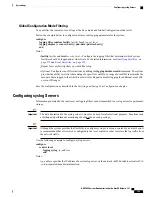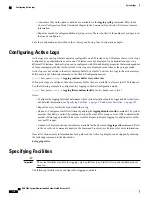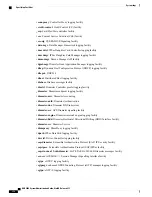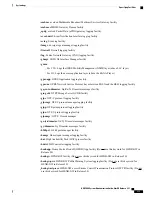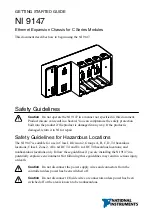
•
Crash log:
Crash logs record all possible information pertaining to a software crash (full core dump).
Due to their size, they can not be stored in system memory. Therefore, these logs are only generated if
the system is configured with a Universal Resource Locator (URL) pointing to a local device or a network
server where the log can be stored.
•
Abridged crash log:
Crash event records are automatically generated when a software crash occurs and
are stored in flash memory on management cards. The abridged crash log contains a list crash event
records along with associated dump files. This log allows you to view event records and dump files via
CLI commands.
Crash Logging Architecture
The crash log is a persistent repository of crash event information. Each event is numbered and contains text
associated with a CPU (minicore), NPU or kernel crash. The logged events are recorded into fixed length
records and stored in /flash/crashlog2.
Whenever a crash occurs, the following crash information is stored:
1
The event record is stored in /flash/crashlog2 file (the crash log).
2
The associated minicore, NPU or kernel dump file is stored in the /flash/crsh2 directory.
3
A full core dump is stored in a user configured directory.
The crashlog2 file along with associated minicore, NPU and kernel dumps are automatically synchronized
across redundant management cards (SMC, MIO/UMIO). Full core dumps are not synchronized across
management cards.
Important
The following behaviors apply to the crash logging process.
•
When a crash event arrives on an active management card, the event record is stored in its crashlog2
file along with the minicore, NPU, or kernel dump file in /flash/crsh2. The crash event and dump file
are also automatically stored in the same locations on the standby management card.
•
When a crash log entry is deleted via CLI command, it is deleted on both the active and standby
management cards.
•
When a management card is added or replaced, active and standby cards will automatically synchronize
crash logs and dump files.
•
When a crash event is received and the crash log file is full, the oldest entry in the crash log and its
related dump file will be replaced with the latest arrived event and dump file on both management cards.
Information for a maximum of 120 crash events can be stored on management cards.
•
Duplicate crash events bump the count of hits in the existing record and update the new record with the
old crash record. Additions to the count use the timestamp for the first time the event happened.
Configuring Software Crash Log Destinations
The system can be configured to store software crash log information to any of the following locations:
•
On the ASR 5000:
ASR 5000 System Administration Guide, StarOS Release 21.1
182
System Logs
Crash Logging Architecture
Summary of Contents for ASR 5000
Page 26: ...ASR 5000 System Administration Guide StarOS Release 21 1 xxvi Contents ...
Page 316: ...ASR 5000 System Administration Guide StarOS Release 21 1 288 VLANs VLAN Related CLI Commands ...
Page 400: ...ASR 5000 System Administration Guide StarOS Release 21 1 372 Engineering Rules ECMP Groups ...


